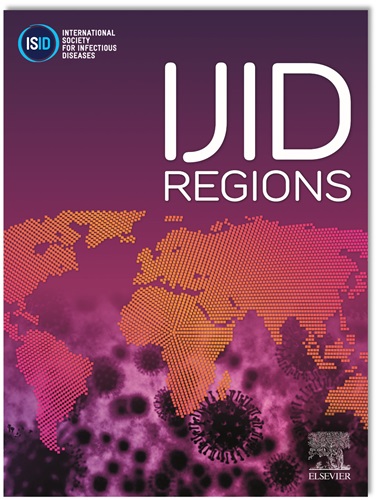Rising Tide of Antibiotic Resistance in Sub-Saharan Africa: A Meta-Analysis of Vibrio cholerae Susceptibility(2014-2024)
IF 4.8
2区 医学
Q1 INFECTIOUS DISEASES
引用次数: 0
Abstract
Introduction
Antibiotics are commonly used alongside rehydration therapy in the management of cholera. Their efficacy is however increasingly compromised by global rise of antibiotic-resistant bacteria. This is particularly concerning in sub-Saharan Africa, where cholera is endemic, recurrent and access to effective antibiotics is highly limited. This study aims to systematically evaluate data on antibiotic resistance in Vibrio cholerae isolates across sub-Saharan Africa.
Methods
We conducted a systematic literature search across PubMed, Scopus, Embase, Google scholar and Web of Science databases to identify articles reporting the susceptibility profiles of Vibrio cholerae isolates from cholera patients between 2014 and April 2024. We utilized the Freeman-Tukey double arcsine transformation to estimate the weighted pooled resistance (WPR). Heterogeneity of the data and bias were analyzed with random effect model meta-analysis and funnel plot. The data were analyzed using Comprehensive Meta-Analysis Software Version 4.0 (Biostat, Englewood, NJ, USA)
Results
This meta-analysis presents results of antibiotics resistance profile of 1761 V. cholerae isolates from 12 countries. The isolates were predominantly O1 El tor serogroup with 71.2% ogawa and 28.8% inaba biotypes. Majority of the studies were from Nigeria (6/22) followed by Ghana (4/22) and Kenya (3/22). Ciprofloxacin (19/22), tetracycline (18/22) and trimethoprim-sulfamethoxazole (17/22) were the most frequently studied antibiotics. The results revealed varying rates of resistance among different antibiotics, with co-trimoxazole 77.99% (C.I.: 0.6702-0.8606) exhibiting the highest resistance, followed by nalidixic acid 67.25 % (C.I.: 0.4625-0.8305) and amoxicillin-clavulanate 74.91 % (C.I.: 0.411- 0.927). The WPR of tetracycline, ciprofloxacin and chloramphenicol were respectively 29.74 % (C.I.: 0.1912-0.4313), 8.41% (C.I.: 0.0423-0.1605) and 32.71 % (0.1708-0.5343). Regional analysis revealed that WPR of tetracycline and ciprofloxacin were highest in Nigeria (60.75 %) and Zambia (59.04 %) respectively. The WPR for tetracycline and ciprofloxacin increased notably after 2020 COVID-19 pandemic, rising from 16.6% (0.0687-0.3499) to 39.1% (0.2314-0.5784) and from 1.5% (0.0042-0.0552) to 16.2% (0.0802-0.2990), respectively. This upward trend was also observed across other antibiotics studied.
Discussion
The meta-analysis reveals a worrying rise in antibiotic resistance among V. cholerae in sub-Saharan Africa. The increasing antibiotic resistance observed both before and after 2020 could potentially be associated with the global rise in antibiotic resistance, possibly stemming from the overuse of antibiotics during the COVID-19 pandemic.
Conclusion
The findings underscore the alarming prevalence of antibiotic resistance among V. cholerae isolates in sub-Saharan Africa. We also noted a lack of data on V. cholerae susceptibility in several countries. With high rates of resistance observed against commonly used antibiotics, the effectiveness of current treatment regimens for cholera is severely compromised. Urgent measures such as enhanced surveillance, judicious antibiotic use, and implementation of antibiotic stewardship are thus urgently needed to address this growing public health threat in the region.
撒哈拉以南非洲地区抗生素耐药性上升趋势:2014-2024年霍乱弧菌药敏荟萃分析
在霍乱治疗中,抗生素通常与补液治疗同时使用。然而,它们的功效日益受到全球耐药细菌增加的影响。这在撒哈拉以南非洲尤其令人担忧,因为那里霍乱是地方性的、反复发生的,而且获得有效抗生素的机会非常有限。本研究旨在系统地评估撒哈拉以南非洲地区霍乱弧菌分离株的抗生素耐药性数据。方法系统检索PubMed、Scopus、Embase、谷歌scholar和Web of Science数据库,筛选2014年至2024年4月霍乱患者分离出的霍乱弧菌的药敏分析文献。我们利用Freeman-Tukey双反正弦变换估计加权池阻力(WPR)。采用随机效应模型meta分析和漏斗图分析数据的异质性和偏倚。采用综合荟萃分析软件4.0版(Biostat, Englewood, NJ, USA)对数据进行分析。结果本荟萃分析提供了来自12个国家的1761株霍乱弧菌的抗生素耐药性分析结果。分离株以o1el - tor血清型为主,其中ogawa生物型占71.2%,inaba生物型占28.8%。大多数研究来自尼日利亚(6/22),其次是加纳(4/22)和肯尼亚(3/22)。环丙沙星(19/22)、四环素(18/22)和甲氧苄啶-磺胺甲恶唑(17/22)是最常被研究的抗生素。结果显示,不同抗生素的耐药率不同,以复方新诺明77.99%(0.6702 ~ 0.8606)的耐药率最高,其次是萘啶酸67.25%(0.4625 ~ 0.8305)和阿莫西林-克拉维酸74.91%(0.411 ~ 0.927)。四环素、环丙沙星和氯霉素的WPR分别为29.74% (ci: 0.1921 ~ 0.4313)、8.41% (ci: 0.0423 ~ 0.1605)和32.71% (ci: 0.1708 ~ 0.5343)。区域分析显示,尼日利亚(60.75%)和赞比亚(59.04%)的四环素和环丙沙星WPR最高。新冠肺炎大流行后,四环素和环丙沙星的WPR分别从16.6%(0.0687-0.3499)上升至39.1%(0.2314-0.5784),从1.5%(0.0042-0.0552)上升至16.2%(0.0802-0.2990)。在研究的其他抗生素中也观察到这种上升趋势。荟萃分析揭示了撒哈拉以南非洲霍乱弧菌抗生素耐药性的令人担忧的上升。2020年前后观察到的抗生素耐药性增加可能与全球抗生素耐药性上升有关,这可能是由于COVID-19大流行期间过度使用抗生素造成的。结论这些发现强调了撒哈拉以南非洲霍乱弧菌中抗生素耐药性的惊人流行。我们还注意到,一些国家缺乏关于霍乱弧菌易感性的数据。由于观察到对常用抗生素的高耐药率,目前霍乱治疗方案的有效性受到严重影响。因此,迫切需要采取紧急措施,如加强监测、明智地使用抗生素和实施抗生素管理,以应对该区域日益严重的公共卫生威胁。
本文章由计算机程序翻译,如有差异,请以英文原文为准。
求助全文
约1分钟内获得全文
求助全文
来源期刊
CiteScore
18.90
自引率
2.40%
发文量
1020
审稿时长
30 days
期刊介绍:
International Journal of Infectious Diseases (IJID)
Publisher: International Society for Infectious Diseases
Publication Frequency: Monthly
Type: Peer-reviewed, Open Access
Scope:
Publishes original clinical and laboratory-based research.
Reports clinical trials, reviews, and some case reports.
Focuses on epidemiology, clinical diagnosis, treatment, and control of infectious diseases.
Emphasizes diseases common in under-resourced countries.

 求助内容:
求助内容: 应助结果提醒方式:
应助结果提醒方式:


